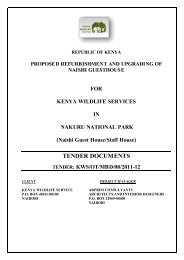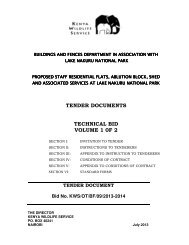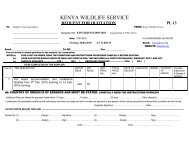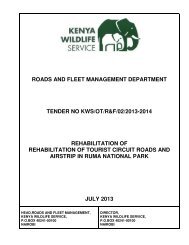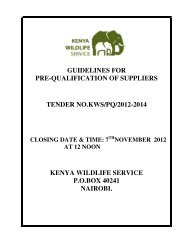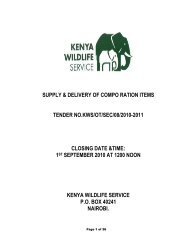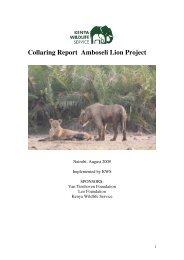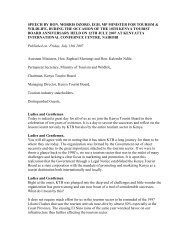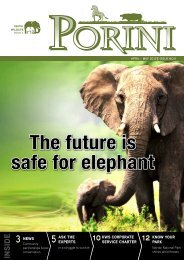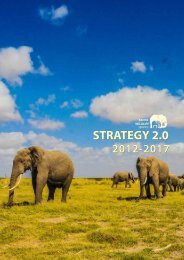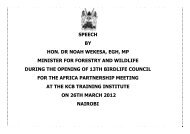Conservation and Management Strategy for the Elephant in Kenya
Conservation and Management Strategy for the Elephant in Kenya
Conservation and Management Strategy for the Elephant in Kenya
Create successful ePaper yourself
Turn your PDF publications into a flip-book with our unique Google optimized e-Paper software.
12 CONSERVATION AND MANAGEMENT STRATEGY FOR THE ELEPHANT IN KENYA<br />
There are several po<strong>in</strong>ts to note from this presentation of data. The first is that <strong>the</strong>re is <strong>in</strong> <strong>the</strong> order of 90,000 –<br />
100,000 km 2 of known elephant range <strong>in</strong> <strong>Kenya</strong>, with an additional 7,000–15,000 km 2 of possible range. It would<br />
appear that <strong>the</strong>re has been a slight decl<strong>in</strong>e <strong>in</strong> <strong>the</strong> amount of known range <strong>in</strong> recent years, but it is also possible that<br />
this change is due to a better def<strong>in</strong>ition of range area ra<strong>the</strong>r than a measurable range contraction. The <strong>in</strong>crease <strong>in</strong><br />
‘Possible’ range area may be partly due to improved <strong>in</strong><strong>for</strong>mation, <strong>and</strong> may also reflect <strong>the</strong> movement of elephants<br />
<strong>in</strong>to new areas. Alterations <strong>in</strong> range between 1925 to 1990 are extensive <strong>and</strong> reflect <strong>the</strong> drivers on elephant<br />
behaviour <strong>in</strong> response to threats <strong>and</strong> habitat change (Parker & Graham, 1989).<br />
A spatial depiction of estimated elephant range as of 2006 is presented <strong>in</strong> <strong>the</strong> map from <strong>the</strong> most recent African<br />
<strong>Elephant</strong> Status Report (Blanc et al., 2007); Figure 11. Several po<strong>in</strong>ts are clear:<br />
1. There is considerable elephant range outside <strong>for</strong>mal PAs.<br />
2. The ma<strong>in</strong> areas of contiguous elephant range are:<br />
i. <strong>the</strong> nor<strong>the</strong>rn coast<br />
ii. <strong>the</strong> Tsavo-Chyulu-Amboseli-Kilimanjaro complex<br />
iii. <strong>the</strong> Aberdare-Mt <strong>Kenya</strong>-Laikipia-Samburu-Nor<strong>the</strong>rn Area complex<br />
iv. <strong>the</strong> Nguruman-Mara-Serengeti complex<br />
v. Nasolot-Romoi-Kerio Valley.<br />
3. The range of <strong>in</strong>dividual populations <strong>in</strong> many cases cross boundaries of KWS <strong>Conservation</strong> Areas,<br />
<strong>in</strong>dicat<strong>in</strong>g <strong>the</strong> need <strong>for</strong> coord<strong>in</strong>ation of management.<br />
4. Some population ranges also cross <strong>in</strong>ternational boundaries, with Tanzania, Ug<strong>and</strong>a <strong>and</strong> Somalia,<br />
with similar implications <strong>for</strong> coord<strong>in</strong>ation of management.<br />
[ OPPOSITE - FIGURE 11 ]<br />
Map of elephant range <strong>in</strong> <strong>Kenya</strong> as of 2006,<br />
from African <strong>Elephant</strong> Status Report (Blanc et<br />
al., 2007). Boundaries of KWS <strong>Conservation</strong><br />
Areas have been added.



